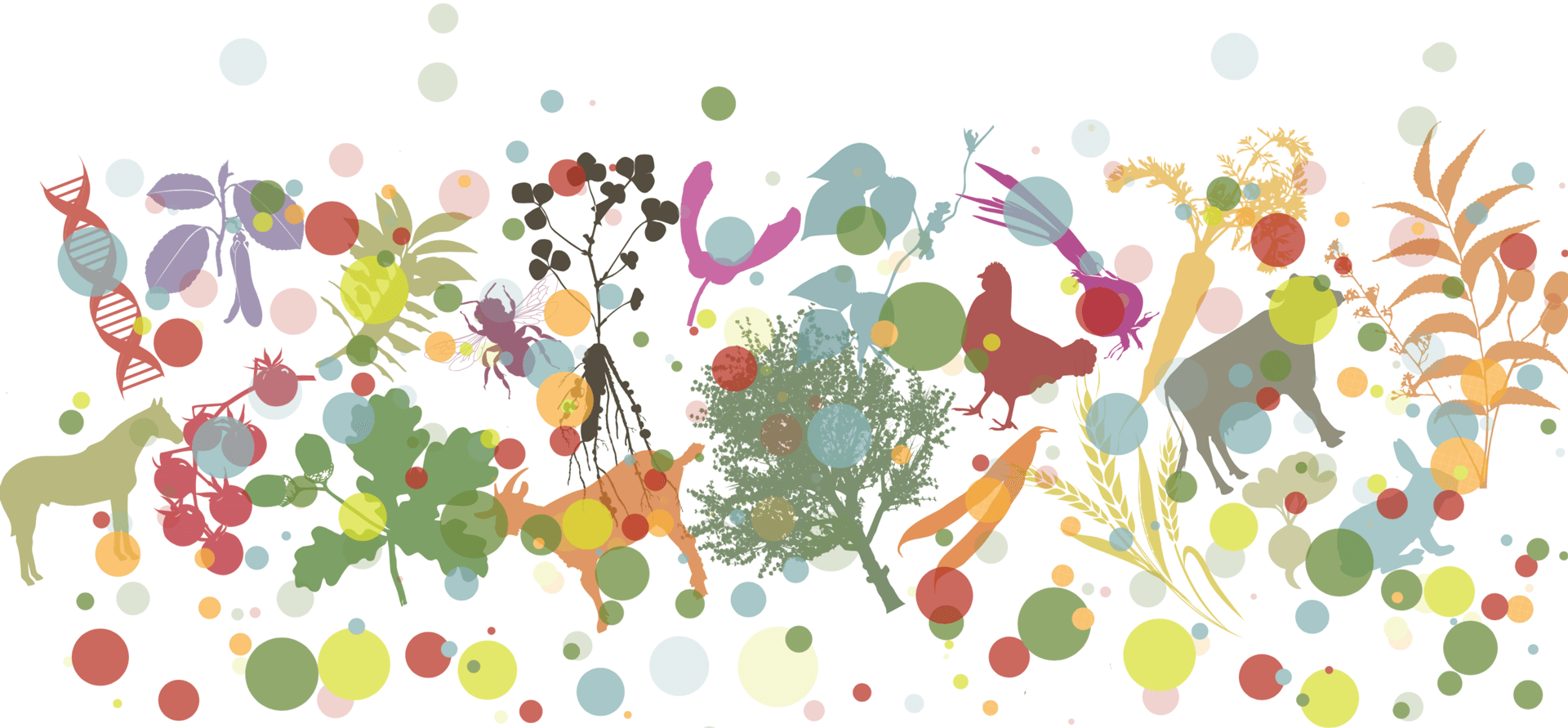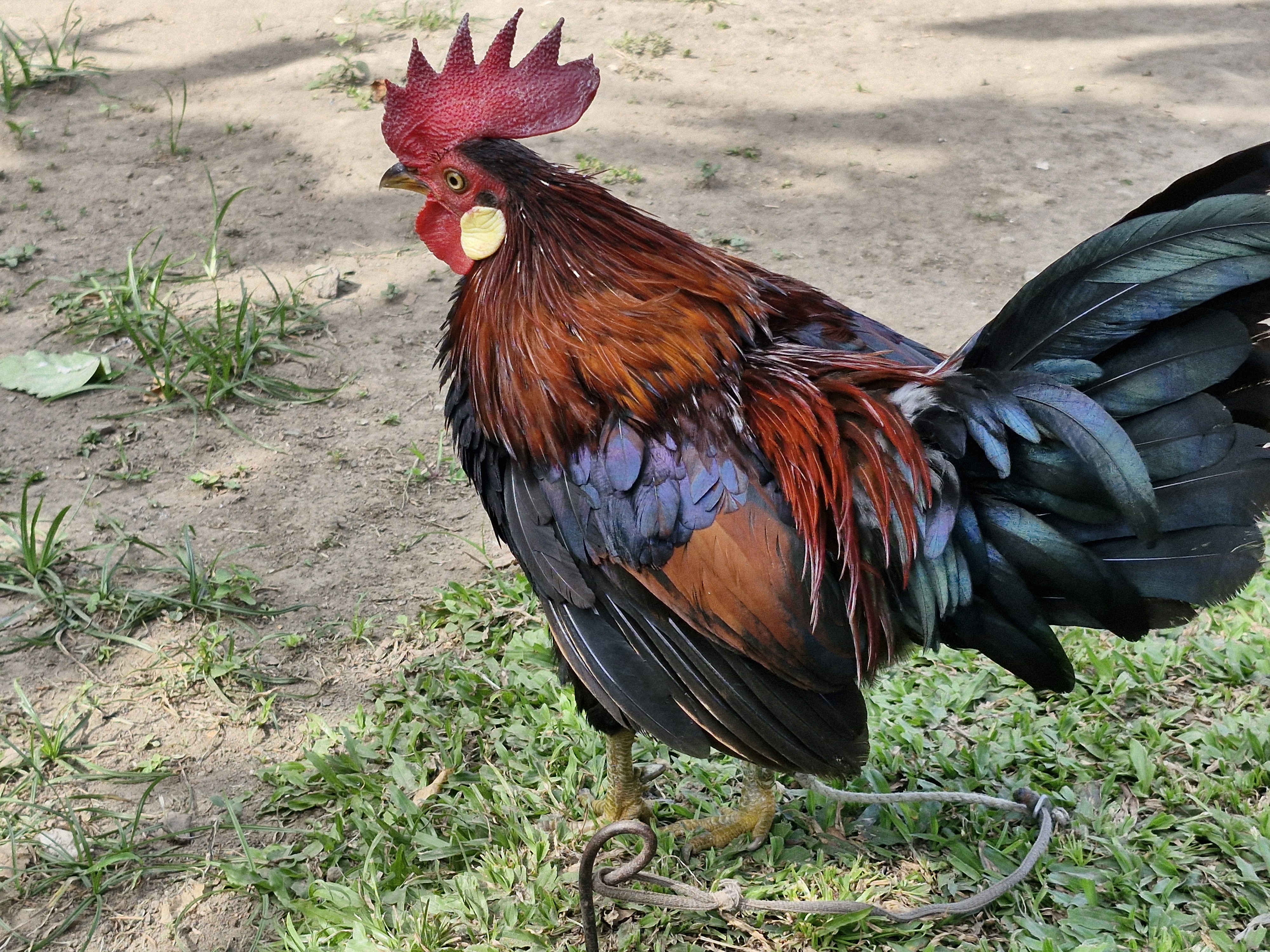Genetic variation of Burgo chicken from Bengkulu, Indonesia, based on the ND1-mitochondrial DNA gene
Main Article Content
Abstract
Burgo chicken Burgo chicken is one of the domesticated red jungle chickens found in Bengkulu Province, Indonesia. Taxonomically, the position of Burgo chicken as a subspecies, species or breed remains unclear due to the lack of supporting data, highlighting the need for further taxonomic identification. We identified two specific sites, 52 and 375, representing single-nucleotide polymorphisms in the ND1 gene, with a gene sequence length of 450bp. Three haplotypes were detected in Burgo chickens, with haplotype 2 shared between Burgo chicken, Gallus gallus (Java) and G. gallus bankiva. The average genetic distance in the Burgo chicken population was 0.1%. When compared to other chicken populations, the average distance was 0.12%, while the distance to other Gallus spp. was 3.62%. All Burgo chickens formed the same clade in the phylogenetic tree, although two individuals (C2F3ND1 and K4F2ND1) showed slight differences. These two individuals were found in Rejang Lebong and Kepahiang, two nearby locations, indicating the possibility that a meeting occurred. Genetic differences within Burgo chickens from Bengkulu, and with other chickens in Indonesia and various parts of the world, were present but not significant. Our data show that Burgo chickens may exhibit differences from other chickens in Indonesia and globally. However, although the genetic data revealed some divergence in mitochondrial DNA, additional morphological and morphometric analyses are needed to provide supporting evidence.
Article Details

This work is licensed under a Creative Commons Attribution 4.0 International License.
Authors retain copyright of the articles published in Genetic Resources and grant the journal right of first publication with open access. All articles published in Genetic Resource are licensed under Creative Commons Attribution 4.0 International License (CC BY 4.0) that allows others to download, share and adapt the work for commercial and non-commercial purposes as long as proper attribution to the original article is given. Genetic Resources permits and encourages authors to post items submitted to the journal (including the publisher's final layout) on personal websites or institutional repositories after acceptance and/or publication, while providing bibliographic details that credit their publication in Genetic Resources.
Al-Nasser, A. et al. (2007) ‘Overview of chicken taxonomy and domestication’, World’s Poultry Science Journal, 63(2), pp. 285–300. doi: https://doi.org/10.1017/S004393390700147X. DOI: https://doi.org/10.1017/S004393390700147X
Amin, H.S., and Mushlih, M (2020). Identification of the Mitochondrial ND1 Gene Carrier of Diabetes Mellitus Type 2 with Blood Samples. Medicra (Journal of Medical Laboratory Science/Technology), 3(2), pp. 48–53. doi: https://doi.org/10.21070/medicra.v3i2.873 DOI: https://doi.org/10.21070/medicra.v3i2.873
Bandelt, H.J., Forster, P., and Röhl, A (1999). Median-joining networks for inferring intraspecific phylogenies. Molecular Biology and Evolution, 16(1), pp. 37–48. doi: https://doi.org/10.1093/oxfordjournals.molbev.a026036. DOI: https://doi.org/10.1093/oxfordjournals.molbev.a026036
Bilgin, R. et al. (2016) ‘DNA barcoding of birds at a migratory hotspot in eastern Turkey highlights continental phylogeographic relationships’, PLoS ONE, 11(6), pp. 1–17. doi: https://doi.org/10.1371/journal.pone.0154454. DOI: https://doi.org/10.1371/journal.pone.0154454
Bowles, J. and Mcmanus, D.P. (1993) ‘NADH dehydrogenase 1 gene sequences compared for species and strains of the genus Echinococcus’, International Journal for Parasitology, 23(7), pp. 969–972. doi: https://doi.org/10.1016/0020-7519(93)90065-7. DOI: https://doi.org/10.1016/0020-7519(93)90065-7
Fouquet, A., et al (2007). Underestimation of Species Richness in Neotropical Frogs Revealed by mtDNA Analyses. (10). doi: https://doi.org/10.1371/journal.pone.0001109. DOI: https://doi.org/10.1371/journal.pone.0001109
Fumihito, A., et al (1994). One subspecies of the red junglefowl (Gallus gallus gallus) suffices as the matriarchic ancestor of all domestic breeds. Proceedings of the National Academy of Sciences of the United States of America, 91(26), pp. 12505–12509. doi: https://doi.org/10.1073/pnas.91.26.12505. DOI: https://doi.org/10.1073/pnas.91.26.12505
Hall, T.A (1999). BioEdit: a user-friendly biological sequence alignment editor and analysis program for Windows 95/98/NT. Nucleic Acids Symposium Series, 41, pp. 95–98.
Hirsch V. (2003) Legal protections of the domestic chicken in the United States and Europe. East Lansing: Michigan State University College of Law; 2003.
Hirst, J (2010). Towards the molecular mechanism of respiratory complex I. Biochemical Journal, 425(2), pp. 327–339. doi: https://doi.org/10.1042/BJ20091382. DOI: https://doi.org/10.1042/BJ20091382
Jarulis, J. et al, (2022). DNA Barcode of Red Junglefowl Gallus gallus L, 1958 (Aves: Phasianidae) of Sumatra Based on Mitochondrial COI DNA Gene. Biosaintifika: Journal of Biology & Biology Education, 14(2), pp. 200–210. doi: https://doi.org/10.15294/biosaintifika.v14i2.36530. DOI: https://doi.org/10.15294/biosaintifika.v14i2.36530
Kimura, M (1980). A simple method for estimating evolutionary rates of base substitutions through comparative studies of nucleotide sequences. Journal of Molecular Evolution, 16(2), pp. 111–120. doi: https://doi.org/10.1007/BF01731581. DOI: https://doi.org/10.1007/BF01731581
Larson, G. et al. (2014) ‘Current perspectives and the future of domestication studies’, PNAS, 111(17), pp. 6139–6146. doi: https://doi.org/10.1073/pnas.1323964111/-/DCSupplemental. DOI: https://doi.org/10.1073/pnas.1323964111
Meseret, S. (2016) ‘A review of poultry welfare in conventional production system’, Live stock Research for Rural Development, 12(28). Available at: http://www.lrrd.org/lrrd28/12/mese28234.html
Liu, Y.P. et al, (2006). Multiple maternal origins of chickens: Out of the Asian jungles. Molecular Phylogenetics and Evolution, 38(1), pp. 12–19. doi: https://doi.org/10.1016/j.ympev.2005.09.014. DOI: https://doi.org/10.1016/j.ympev.2005.09.014
Miao, Y.W. et al. (2013) ‘Chicken domestication: An updated perspective based on mitochondrial genomes’, Heredity, 110(3), pp. 277–282. doi: https://doi.org/10.1038/hdy.2012.83. DOI: https://doi.org/10.1038/hdy.2012.83
Nataamijaya, A.G. (2010). Developing the Potential of Local Chickens to Support Improved Farmer Welfare (in Indonesian), Jurnal Litbang Peternakan, 29(10), pp. 131–138.
Nataannjaya, A.G. (2000) ‘The Native Chicken of Indonesia’, Buletin Plasma Nutfah.
Ni’mah, A. et al, (2016). Detection of Pork Contaminantion in Fresh and Cooked Beef Using Geetic Marker Mitochondrial-DNA Cytochrome B by Duplex-PCR. Journal of the Indonesia Tropical Animal Agriculture, 4(1), pp. 88–100. doi: https://doi.org/10.14710/jitaa.41.1.7-12. DOI: https://doi.org/10.14710/jitaa.41.1.7-12
Putranto, H.D. et al. (2017) ‘The estimation of dynamical distribution of domesticated Burgo chicken population in Bengkulu coastal area, Indonesia’, Biodiversitas, 18(2), pp. 458–464. doi: https://doi.org/10.13057/biodiv/d180203. DOI: https://doi.org/10.13057/biodiv/d180203
Rafian, T., Jakaria, J., and Ulupi, N (2017). Phenotypic Diversity of Qualitative Traits of Burgo Chicken in Bengkulu Province, Jurnal Sain Peternakan Indonesia, 12(1), pp. 47–54. doi: https://doi.org/10.31186/jspi.id.12.1.47-54. DOI: https://doi.org/10.31186/jspi.id.12.1.47-54
Raharjo, T.J. et al. (2018) Mitochondrial ND-1 gene-specific primer polymerase chain reaction to determine mice contamination in meatball. International Food Research Journal, 25(2): 638-642. url: http://www.ifrj.upm.edu.my/25%20(02)%202018/(26).pdf
Rozas, J. et al, (2017). DnaSP 6: DNA sequence polymorphism analysis of large data sets. Molecular Biology and Evolution, 34(12), pp. 3299–3302. doi: https://doi.org/10.1093/molbev/msx248. DOI: https://doi.org/10.1093/molbev/msx248
Safitra, M.I., Putranto, H.D., and Brata, B (2022). Characteristics of the crowing sound of male Burgo chickens in Bengkulu City (in Indonesian), Jurnal Peternakan, 19(1), p. 64. doi : https://doi.org/10.24014/jupet.v19i1.15047. DOI: https://doi.org/10.24014/jupet.v19i1.15047
Setianto, J., Prakoso, H., and Sutriyono (2013). Laporan penelitian. 22(2), pp. 184–206.
Seutin G, White BN, Boag PT (1991). Preservation of avian blood and tissue samples for DNA analysis. Can. J. Zool. 69:82-90. doi: https://doi.org/10.1139/z91-013 DOI: https://doi.org/10.1139/z91-013
Sibley, C.G. & B.L. Monroe. 1990. Distribution and Taxonomy of Birds of the World. Yale University Press. New Haven & London. P 1111.
Sulandari, S., Syamsul Arifin Zein, M., and Sartika, T (2008). Molecular Characterization of Indonesian Indigenous Chickens based on Mitochondrial DNA Displacement (D)-loop Sequences. HAYATI Journal of Biosciences, 15(4), pp. 145–154. doi: https://doi.org/10.4308/hjb.15.4.145. DOI: https://doi.org/10.4308/hjb.15.4.145
Sulandari, S., M.S.A. Zein, S. Paryanti & T. Sartika. 2007. Taksonomi dan asal usul ayam domestikasi. Dalam: K. Diwyanto & S.N. Prijono (Eds.). Keragaman Sumber Daya Hayati Ayam Lokal Indonesia: Manfaat dan Potensi. Pusat Penelitian Biologi, LIPI. ISBN 978-979-799-183-8. Edisi Pertama. Hal. 7-24.
Sutriyono, S. (2016) Production and population of domesticated red jungle fowl in North Bengkulu Regency and population development scenarios (in Indonesian), Pros Sem NAs Masy Biodiv Indon, 2, pp. 226–231. doi: https://doi.org/10.13057/psnmbi/m020218. DOI: https://doi.org/10.13057/psnmbi/m020218
Tamura, K. et al, (2013). MEGA6: Molecular evolutionary genetics analysis version 6.0. Molecular Biology and Evolution, 30(12), pp. 2725–2729. doi: https://doi.org/10.1093/molbev/mst197. DOI: https://doi.org/10.1093/molbev/mst197
Torres, J.B (2016). A history of you, me, and humanity: mitochondrial DNA in anthropological research. AIMS Genetics, 03(02), pp. 146–156. doi: https://doi.org/10.3934/genet.2016.2.146. DOI: https://doi.org/10.3934/genet.2016.2.146
Utama, A.F. et al, (2023). DNA barcoding of Burgo chicken from Bengkulu, Indonesia, based on the cytochrome oxidase gene sub unit I mitochondria DNA. Biodiversitas, 24(11), pp. 6256–6263. doi: https://doi.org/10.13057/biodiv/d241148. DOI: https://doi.org/10.13057/biodiv/d241148
Väisänen, J., Håkansson, J. and Jensen, P. (2005) ‘Social interactions in Red Junglefowl (Gallus gallus) and White Leghorn layers in stable groups and after re-grouping’, British Poultry Science, 46(2), pp. 156–168. doi: https://doi.org/10.1080/00071660500062638. DOI: https://doi.org/10.1080/00071660500062638
Wang, M.S. et al. (2020) ‘863 genomes reveal the origin and domestication of chicken’, Cell Research, 30(8), pp. 693–701. doi: https://doi.org/10.1038/s41422-020-0349-y. DOI: https://doi.org/10.1038/s41422-020-0349-y
Warmadewi, D.A. et al, (2020). The variation of phenotypics Bali cattle in Bali Province, Indonesia. International Journal of Fauna and Biological Studies, 7(4), pp. 44–47.
Widayanti, R. et al. (2022) ‘Study of Genetic Diversity of Native Indonesian Catfish Based on Nucleotide Sequences of the ND1 Gene’, Jurnal Sain Veteriner, 40(3), p. 268. doi: https://doi.org/10.22146/jsv.62755. DOI: https://doi.org/10.22146/jsv.62755
Zein, M.S.A., and Sulandari, S (2008). Genetic diversity of Lombok chickens based on D-loop mitochondrial DNA sequences. JITV 13(4): 307-314.
Zein, M.S.A., and Sulandari, S. (2012) Genetic Diversity and Haplogroup Distribution of Native Chicken Using Hypervariable-I Control Region of Mitochondrial DNA (in Indonesian), JITV, 17(2): 120-131. DOI: https://doi.org/10.14334/jitv.v17i2.686







 This journal has been conceived as part of the
This journal has been conceived as part of the